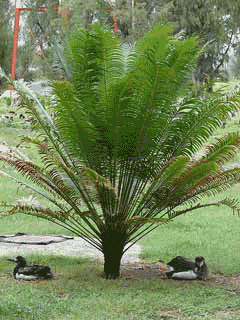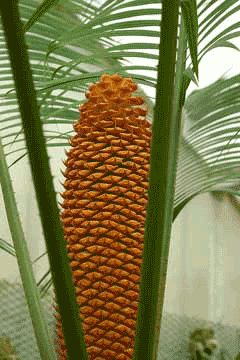 |
|
http://www.hear.org/starr/ |
 |
| http://flickr.com/photos/39312862%40N00 |
Translate this page:
Summary
Form: Palm.
Physical Characteristics

 Cycas circinalis is an evergreen Shrub growing to 3.5 m (11ft 6in) at a slow rate.
Cycas circinalis is an evergreen Shrub growing to 3.5 m (11ft 6in) at a slow rate.
See above for USDA hardiness. It is hardy to UK zone 10 and is frost tender. It is in leaf all year. The species is dioecious (individual flowers are either male or female, but only one sex is to be found on any one plant so both male and female plants must be grown if seed is required). and is pollinated by Insects, wind. The plant is not self-fertile.
It can fix Nitrogen.
Suitable for: medium (loamy) and heavy (clay) soils and prefers well-drained soil. Suitable pH: mildly acid, neutral and basic (mildly alkaline) soils. It cannot grow in the shade. It prefers dry or moist soil.
UK Hardiness Map
US Hardiness Map
Synonyms
C. beddomei.
Plant Habitats
Woodland Garden Sunny Edge; Dappled Shade; South Wall. By. West Wall. By.
Edible Uses
Edible Parts: Leaves Seed Stem
Edible Uses: Gum
The pith is rich in carbohydrate and a sago can be made from it[2, 46, 61, 177]. This use will kill the plant[K]. The raw seed is poisonous, but after being cut into thin slices, dried, then steeped in water for a few minutes and dried again, it becomes edible[2, 61, 63, 146, 177]. It can be used as a sago[2]. Using the seed for food cannot be recommended, however. See the notes above on toxicity. The very young leaves are edible[177]. The plant yields a gum[64, 146, 171]. No further details are given.
References More on Edible Uses
Medicinal Uses
Plants For A Future can not take any responsibility for any adverse effects from the use of plants. Always seek advice from a professional before using a plant medicinally.
Narcotic Poultice Stomachic
The pollen is narcotic[240]. The bark and the seeds are ground to a paste with oil and used as a poultice on sores and swellings[240]. The juice of tender leaves is useful in the treatment of flatulence and vomiting[240].
References More on Medicinal Uses
The Bookshop: Edible Plant Books
Our Latest books on Perennial Plants For Food Forests and Permaculture Gardens in paperback or digital formats.

Edible Tropical Plants
Food Forest Plants for Hotter Conditions: 250+ Plants For Tropical Food Forests & Permaculture Gardens.
More

Edible Temperate Plants
Plants for Your Food Forest: 500 Plants for Temperate Food Forests & Permaculture Gardens.
More

More Books
PFAF have eight books available in paperback and digital formats. Browse the shop for more information.
Shop Now
Other Uses
References More on Other Uses
Cultivation details
Landscape Uses:Border, Container, Specimen. Requires a strong loam with sharp sand and good drainage[1]. Succeeds in dry soils. Requires a sunny position[188]. This species is not fully hardy in Britain and requires greenhouse or conservatory protection over the winter, but it can be grown outdoors in the summer[1]. Plants are slow-growing[188]. This plant is often used as a food source in its native range but recent research has shown that it can cause chronic nervous disorders if it is not treated properly. Overall its use is not to be recommended, especially since it is becoming rare in the wild[200]. The plants produce special upward growing roots where nitrogen is produced in symbiosis with algae[175]. Dioecious, male and female plants must be grown if seed is required. Special Features:
Attractive foliage, Not North American native, All or parts of this plant are poisonous, There are no flowers or blooms.
References Carbon Farming Information and Carbon Sequestration Information
Temperature Converter
Type a value in the Celsius field to convert the value to Fahrenheit:
Fahrenheit:
The PFAF Bookshop
Plants For A Future have a number of books available in paperback and digital form. Book titles include Edible Plants, Edible Perennials, Edible Trees,Edible Shrubs, Woodland Gardening, and Temperate Food Forest Plants. Our new book is Food Forest Plants For Hotter Conditions (Tropical and Sub-Tropical).
Shop Now
Plant Propagation
Seed - best sown in a greenhouse as soon as it is ripe, 2cm deep in individual pots which are then sealed in plastic bags to keep them moist until germination takes place. Germinates in 1 - 3 months at 25°c[164]. Pre-soak stored seed for 24 hours in warm water then treat as above. Division of suckers in the spring[188].
Other Names
If available other names are mentioned here
Native Plant Search
Search over 900 plants ideal for food forests and permaculture gardens. Filter to search native plants to your area. The plants selected are the plants in our book 'Plants For Your Food Forest: 500 Plants for Temperate Food Forests and Permaculture Gardens, as well as plants chosen for our forthcoming related books for Tropical/Hot Wet Climates and Mediterranean/Hot Dry Climates. Native Plant Search
Found In
Countries where the plant has been found are listed here if the information is available
Weed Potential
Right plant wrong place. We are currently updating this section.
Please note that a plant may be invasive in one area but may not in your area so it’s worth checking.
Conservation Status
IUCN Red List of Threatened Plants Status :

Growth: S = slow M = medium F = fast. Soil: L = light (sandy) M = medium H = heavy (clay). pH: A = acid N = neutral B = basic (alkaline). Shade: F = full shade S = semi-shade N = no shade. Moisture: D = dry M = Moist We = wet Wa = water.

Expert comment
Author
L.
Botanical References
58200
Links / References
For a list of references used on this page please go here
Readers comment